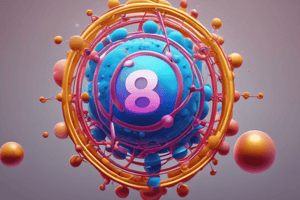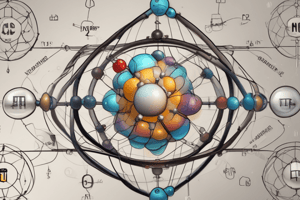Podcast
Questions and Answers
Which combination of particles is found within the nucleus of an atom?
Which combination of particles is found within the nucleus of an atom?
- Neutrons and electrons
- Protons, neutrons, and electrons
- Protons and electrons
- Protons and neutrons (correct)
The atomic number of an element is determined by the number of neutrons in the nucleus.
The atomic number of an element is determined by the number of neutrons in the nucleus.
False (B)
If an atom has 12 protons and 13 neutrons, what is its mass number?
If an atom has 12 protons and 13 neutrons, what is its mass number?
25
An atom that has gained electrons becomes a negatively charged ____.
An atom that has gained electrons becomes a negatively charged ____.
Match the particle with its type of charge:
Match the particle with its type of charge:
What defines isotopes of the same element?
What defines isotopes of the same element?
The relative isotopic mass is the mass of an atom of an isotope relative to 1/12 the mass of a hydrogen-1 atom.
The relative isotopic mass is the mass of an atom of an isotope relative to 1/12 the mass of a hydrogen-1 atom.
Define relative atomic mass (RAM).
Define relative atomic mass (RAM).
If an element has two isotopes with masses of 10 and 11, occurring at 50% abundance each, the RAM is ____.
If an element has two isotopes with masses of 10 and 11, occurring at 50% abundance each, the RAM is ____.
What type of radiation is composed of helium nuclei?
What type of radiation is composed of helium nuclei?
Gamma rays are low-energy electromagnetic waves.
Gamma rays are low-energy electromagnetic waves.
What is half-life?
What is half-life?
After two half-lives, a radioactive sample will have ____% of its original radioactive material.
After two half-lives, a radioactive sample will have ____% of its original radioactive material.
Match each radiation type with its composition or property:
Match each radiation type with its composition or property:
How is carbon-14 produced?
How is carbon-14 produced?
Carbon-14 dating is ineffective for materials older than 100,000 years.
Carbon-14 dating is ineffective for materials older than 100,000 years.
What happens to the ratio of carbon-14 to carbon-12 in an organism after it dies?
What happens to the ratio of carbon-14 to carbon-12 in an organism after it dies?
Carbon-14 decays by emitting a ____ particle.
Carbon-14 decays by emitting a ____ particle.
Match each term with its description in carbon dating:
Match each term with its description in carbon dating:
In a balanced nuclear equation, what must be conserved?
In a balanced nuclear equation, what must be conserved?
Bombarding an element with alpha particles can never result in the production of a new element.
Bombarding an element with alpha particles can never result in the production of a new element.
What is the function of neutrons in a nuclear bombardment reaction?
What is the function of neutrons in a nuclear bombardment reaction?
In nuclear equations, the total number of protons and neutrons must be ____ on both sides of the equation.
In nuclear equations, the total number of protons and neutrons must be ____ on both sides of the equation.
Match each particle with its description in nuclear reactions:
Match each particle with its description in nuclear reactions:
What is the maximum number of electrons that a 'p' subshell can hold?
What is the maximum number of electrons that a 'p' subshell can hold?
Each orbital can hold a maximum of one electron.
Each orbital can hold a maximum of one electron.
How many orbitals are in a d-subshell?
How many orbitals are in a d-subshell?
Electrons first fill lower energy ____ before occupying higher energy levels.
Electrons first fill lower energy ____ before occupying higher energy levels.
Why does the first ionization energy generally increase across a period in the periodic table?
Why does the first ionization energy generally increase across a period in the periodic table?
Second electron affinities are generally exothermic.
Second electron affinities are generally exothermic.
Flashcards
What are protons?
What are protons?
Positively charged particles in the nucleus.
What are neutrons?
What are neutrons?
Neutral particles found in the nucleus.
What are electrons?
What are electrons?
Negatively charged particles that orbit the nucleus.
What is the Proton number (atomic number)?
What is the Proton number (atomic number)?
Signup and view all the flashcards
What is the Nucleon number (mass number)?
What is the Nucleon number (mass number)?
Signup and view all the flashcards
What are Isotopes?
What are Isotopes?
Signup and view all the flashcards
What is Relative isotopic mass?
What is Relative isotopic mass?
Signup and view all the flashcards
What is Relative atomic mass (RAM)?
What is Relative atomic mass (RAM)?
Signup and view all the flashcards
What is Radioactive decay?
What is Radioactive decay?
Signup and view all the flashcards
What is an alpha particle?
What is an alpha particle?
Signup and view all the flashcards
What is a beta particle?
What is a beta particle?
Signup and view all the flashcards
What are gamma rays?
What are gamma rays?
Signup and view all the flashcards
What is Half-life?
What is Half-life?
Signup and view all the flashcards
What are electron shells?
What are electron shells?
Signup and view all the flashcards
What are electron subshells?
What are electron subshells?
Signup and view all the flashcards
What are Orbitals?
What are Orbitals?
Signup and view all the flashcards
What is the Aufbau principle?
What is the Aufbau principle?
Signup and view all the flashcards
What is Electrons-in-boxes notation?
What is Electrons-in-boxes notation?
Signup and view all the flashcards
What is Ionisation energy?
What is Ionisation energy?
Signup and view all the flashcards
What are Successive ionization energies?
What are Successive ionization energies?
Signup and view all the flashcards
What is Electron affinity?
What is Electron affinity?
Signup and view all the flashcards
Study Notes
Fundamental Particles
- Atoms comprise protons, electrons, and neutrons
- Protons, neutrons, and electrons are fundamental particles
- Atoms feature a positively charged nucleus at the center
- Negatively charged electrons surround the nucleus in shells at specific distances
Charges and Relative Weights
- Proton: positive charge
- Neutron: neutral charge
- Electron: negative charge
Atomic and Mass Numbers
- Proton or atomic number: the quantity of protons in an atom's nucleus
-
of protons identifies the element.
- Nucleon or mass number: total count of protons and neutrons in an atom's nucleus
- Electron number: number of electrons in an atom or ion
- In neutral particles, the number of electrons equals the number of protons
- In cations the # of electrons is less than the # of protons because they are positively charged
- In anions the # of electrons is greater than the # of protons because they are negatively charged
Isotopes
- Isotopes: forms of the same element
- Isotopes have equal proton numbers
- Isotopes have different mass numbers due to varying neutron numbers
- Relative isotopic mass: the mass of an isotope concerning 1/12 of a carbon-12 atom
Relative Atomic Mass
- Relative atomic mass (RAM): the weighted average of atomic masses for a given element
- RAM is relative to 1/12 the mass of carbon-12 atoms.
Mechanistic Studies Using Isotopes
- Oxygen exists as oxygen-16 (most common) and oxygen-18
- Carboxylic acid contains oxygen-16
- Alcohol contains oxygen-18
- Carboxylic acid and alcohol can react together with a H+ catalyst
- Products are analyzed by measuring RMM using mass spectroscopy
- Products will have an RMM of 90 for ethyl ethanoate and an RMM of 18 for water
- The oxygen-18 from the alcohol becomes part of the ester
- Alcohol loses a hydrogen (O-H bond breaks)
- Carboxylic acid loses an OH (C-O bond breaks)
- H and OH lost combine to form water, producing an ester
Radioactivity
- Radioactive decay: nuclei lose energy via alpha, beta, and gamma rays
- Unstable nuclei transform into more stable nuclei during decay
- Alpha particles include helium nuclei with two protons and two neutrons
- Beta particles include high-speed electrons
- Gamma rays include high-energy electromagnetic waves.
Alpha, Beta, and Gamma Properties
- Alpha particles have a low penetrating power
- Alpha particles can stopped by paper
- Beta particles have moderate penetrating power
- Beta particles can be stopped by aluminum
- Gamma rays have high penetrating power
- Gamma rays can be stopped by thick lead or concrete
Half-Life
- Half-life: the duration for half the atomic nuclei in a radioactive sample to decay
Atomic Orbitals
- Shells: 1, 2, 3, etc.
- "s" subshells: maximum of 2 electrons
- "p" subshells: maximum of 6 electrons
- "d" subshells: maximum of 10 electrons
- "f" subshells: maximum of 14 electrons
- Orbitals can contain up to two electrons with opposite spins.
- s-subshell: one spherical orbital
- p-subshell: three dumbbell-shaped orbitals at 90° angles
- d-subshell: five orbitals
- f-subshell: seven orbitals
Filling Order
- Aufbau principle: electrons fill lower energy orbitals first
- Each orbital that is the same energy level occupies unpaired electrons before electrons pair up
- 1s 2s 2p 3s 3p 4s 3d 4p 5s 4d 5p 6s is the order in which electrons are filled
Studying That Suits You
Use AI to generate personalized quizzes and flashcards to suit your learning preferences.




